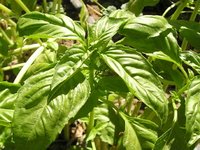
Storms, hailstorms to be exact, have literally been responsible for a pesto shortage. According to the AP, “Hailstones the size of tennis balls smashed glass panes on scores of greenhouses and pummeled fragile basil plants this month, wiping out entire crops near the town of Pra, west of Genoa, the capital of the Liguria region in northwest Italy.”
While basil is grown throughout Italy, Pra is the heart of Genovese basil, which is considered the true ingredient in pesto, which was invented in the port city of Genoa. The University of Wisconsin notes this type of basil has the following characteristics: “…is a standard, flat-leafed Italian type commonly used for making pesto. The leaves are 3-4 inches long and 2-3 inches wide, with a sweet, spicy taste. Plants can reach 5 feet, but are more productive if kept pruned back.”
With some 35 producers suffering $6.5 million in damages, high-quality pesto production is expected to suffer though industrial production of pesto should remain unaffected.
Mouldy coffee beans found in an Italian port are in part to blame for rising coffee prices in Italy, according to Beverage Daily. “Sacks of Robusta coffee beans stored at warehouses in the Italian Port of Trieste were still being held this week, as investigators tried to work out how much of the stock had gone mouldy,” the publication reports. Apparently. Robusta coffee supplies are used as a benchmark for calculating coffee price futures.
The International Coffee Organisation reports coffee prices have risen significantly over the last couple of months and the ongoing problems in Trieste increase the chance of a continued rise in prices next month.

